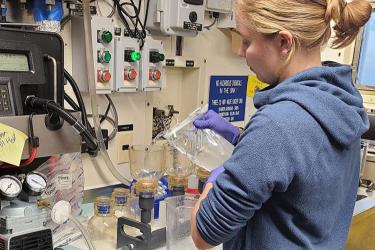Good-paying jobs. Food safety and economic security.
It’s what Alaskans have come to expect from their multi-billion dollar fishing industry. Alaska fisheries are renowned for being among the best-managed sustainable fisheries in the world.
Could Alaska also become known for its environmentally sustainable mariculture products? The Alaska Mariculture Task Force has established a goal of developing a $100 million mariculture industry in 20 years. They plan to achieve this through the enhancement, restoration, and farming of shellfish and seaweed.
To help Alaska advance towards this goal, NOAA Fisheries and the Pacific States Marine Fisheries Commission hosted the first Alaska Mariculture Workshop. The workshop, held on January 21-22, 2020 in Ketchikan, brought together more than 60 participants to help advance mariculture development in Alaska. They included aquatic farmers, industry representatives, tribal representatives, state and federal policy makers and regulators, non-profits, and researchers.
Why Is Alaska the Right Place for Mariculture?
Aquatic farming, if done responsibly, is increasingly recognized as one of the most environmentally sustainable ways to produce food and protein.
NOAA Fisheries recognizes that marine aquaculture is an important and growing U.S. industry. It has the potential to provide a significant sustainable supply of healthy seafood for domestic and global markets to complement wild-capture fisheries.
With more coastline than all the Lower 48 states combined, Alaska is uniquely positioned to seize the marine aquaculture opportunity. Alaska currently has 71 active mariculture operations, including the largest kelp farm in the United States.
Marine aquaculture operations can provide a year-round source of high-quality jobs and economic opportunities that augment seasonal tourism and commercial and recreational fishing in Alaska. It is part of NOAA Fisheries’ sustainable seafood portfolio and the agency’s strategy for economic and environmental resiliency.
Mariculture Workshop: Mapping a Way Forward
The workshop was designed to share NOAA's commitment to fostering aquaculture nationally and regionally, listen to the needs of Alaskans, identify opportunities, and promote future partnerships.
The two-day event built on the foundational work of the Alaska Mariculture Task Force, established in 2016. The Task Force established a goal of developing a $100 million mariculture industry in 20 years and outlined recommendations to achieve this goal in the 2018 Mariculture Development Plan. Aquatic farming will provide long-term benefits for the state’s economy, environment, and communities.
Workshop sessions were framed to identify the mariculture industry needs related to research, policy and permitting, and access to capital. They also focused on developing a shared vision for the future.
Participation by NOAA leadership emphasized the agency’s strategic focus on aquaculture nationally, and commitment regionally. Workshop attendees included NOAA Fisheries Office of Aquaculture Acting Director David O'Brien and Science Advisor Mike Rust, and Alaska Fisheries Science Center Director Bob Foy. They all made presentations. Alaska Regional Administrator Jim Balsiger introduced his office’s new Aquaculture Coordinator, Alicia Bishop.
Bishop described her new role, and several ways she could provide support for Alaska’s mariculture industry.
“Marine aquaculture in Alaska is still developing,” said Bishop. “That gives us lots of opportunities to learn from other regions and parts of the world, and craft a program that is right for Alaska, our people, and our natural resources.”
Bishop also stressed the importance of collaboration and partnerships as keys for success. The theme of “partnerships in action” explored how the agency can remove barriers and provide opportunities for this emerging industry.
The information gathered from the workshop will be used to create a strategic roadmap. It will also help identify key next steps the agency can take to help foster sustainable mariculture development in Alaska.
Learn more about topics discussed and decisions made at the workshop.
More than ever, Alaska’s blue economy future looks bright through science-based sustainable management of wild-caught fisheries and mariculture-produced foods from the ocean.
Note: Caption for photo of aquaculture operation was corrected to the Seagrove Kelp Company's farm in Doyle Bay, Alaska.





